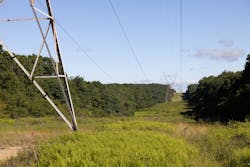Mechanized mowing has been a mainstay of utility vegetation management programs for decades. The practice provides short-term relief from incompatible vegetation and helps prevent problematic trees from jeopardizing the integrity of utility infrastructure. However, there are notable downfalls to using this particular strategy exclusively, and increased costs may be the most significant.
Utility companies and their vegetation management partners have a considerable opportunity to enhance cost efficiency by adopting selective herbicide applications as part of an Integrated Vegetation Management (IVM) program. Celebrated for their ability to control target vegetation without causing harm to desirable plant species, selective herbicide treatments can provide benefits that lead to long-term cost efficiency as well as residual benefits for industry practitioners.
Fewer Maintenance Inputs
Unlike selective herbicide applications, which can selectively control targeted plant species, mechanized mowing controls all vegetation in its path, spreading seeds and stimulating incompatible plant growth along the way. By supporting native plant development, IVM helps create a natural barrier against problematic vegetation, which improves the impact of mowing practices over time and reduces long-term maintenance needs.
“I can build a long-term vegetation management plan that covers my whole system using Integrated Vegetation Management,” says Lew Payne, ROW environmental manager with New York Power Authority. “Once everything is set up properly, my costs are going to come down over time and the amount of herbicide I apply per acre is going to be reduced as well. If you start mowing more often, the non-compatibles will come back in full force and you’ve got to mow more frequently, which will bring your costs back up.”
Lower Stem Counts
By following up mechanical treatments with selective herbicide applications, IVM practitioners can suppress the resprouting or regrowth of problematic woody species that inhibit the development of desirable low-growing plant communities, which are compatible with both utility infrastructure and native wildlife. As a result, compatible plant development impedes the reestablishment of incompatible stems over time.
“There’s an incredible efficiency gain when you implement Integrated Vegetation Management,” says Steve Hilbert, general manager, technical services with Asplundh Tree Expert, LLC. “Over time, you’ll have fewer stems per acre and the vegetation you aim to maintain is likely to be a lot smaller than if you were to rely on mowing alone.”
Program FlexibilityAs a result of crowding out and preventing undesirable tree growth, utility vegetation management programs can effectively reduce tree heights, which allows practitioners to extend treatment cycles over time and significantly lower annual maintenance costs. This gives vegetation managers the flexibility needed to reallocate resources for new technology investments or areas in need of timely maintenance.
For more information on the economic benefits IVM practices can provide to utility vegetation management programs, click here.
To learn more about the manner in which IVM programs support biodiversity and enhance environmental sustainability, visit HabitatWithHerbicides.com.
™ ® Trademarks of Corteva Agriscience and its affiliated companies. © 2022 Corteva.
Sponsored By:

